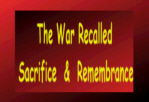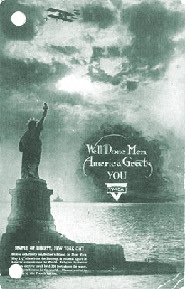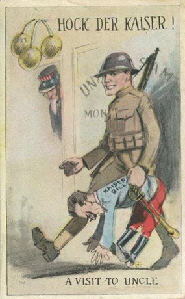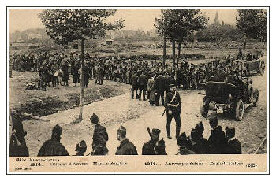
|
|||||||||
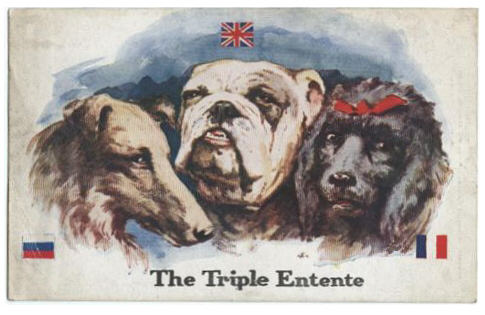 The postcard was "invented" in Austria in 1869, as a way of increasing post office business by reducing the time and postage of letter-writing, and their popularity quickly spread throughout Europe. At first only pre-stamped, plain cardboard postcards were used, but soon they carried all manner of artwork and photographs besides their personal message. The postcard industry reached its peak during World War I, as millions of civilians and soldiers sent hasty messages back and forth. Soldiers at the front could only send terse, pre-printed cards from the trenches ("I am well", "I am wounded", "I am in receipt of your letter", etc.), but they could easily find commercial postcards in the villages just behind the front lines. The civilians on the Home Front had a vast array of sentimental or humorous or patriotic postcards to send to their boys. Whereas the photographs and pictures are wonderful social records of the war, I find the handwritten messages on the postcards' other side even more intriguing. I can't help wondering about the sender and the recipient - did he survive the war? did they ever meet again? what else was happening on the Western Front that day? Some clues can be found with a magnifying glass, a map, and a little help from www.Google.com.
Dear Sir, A few comrades and I received for Christmas some tobacco for which you subscribed so kindly. We did enjoy it very much and we are very pleased to be able to send you our thanks as we found your address in the parcels. As I can write a little English my friends asked to write to thank you. Useless to say that it is with the greatest pleasure that I perform this duty. If perhaps you should know anybody who would like to correspond with a Belgian soldier in the trenches. Would you be so kind to give my address? I should be delighted to have somebody to write to. With kindest regards and renewed thanks my comrades and I send our best wishes of good luck and good health to you and yours. Yours respectfully & gratefully.... Mr. Smith must have donated money to an American organization sending Christmas packages to soldiers at the Front, perhaps the Red Cross. The card is stamped by the military censor ("Censure Militaire") and bears a Belgian stamp, but the postmark is illegible. Because Germany occupied most of Belgium in 1917 and 1918, this Belgian soldier must have been writing from the tiny unoccupied corner of his country between the English Channel and the British Army at Ypres. Did he survive the eleven months until the Armistice, and did Mr. Smith ever respond?
My very dear Marthe, Very good to receive the letter. I'll write one later. I hope you are in good health. Things are good here with us. Etienne has been mobilized since February 21 (Note: this was the first day of the Battle of Verdun). He is at your border, on the other side of Porrentruy, quite close to you. We are very busy all the time - the advance recommences in force in the countryside. If this abominable war ever ends, at least the carnage and the misery will too. Your devoted Evelin - don't forget me. It is postmarked Neuchatel, Switzerland, and bears a Swiss stamp. This is hard to understand, since Switzerland remained neutral throughout the war - perhaps Evelin was on leave at Neuchatel, or perhaps he gave it to someone else to mail. Porrentruy is indeed quite close to the recipient in Belfort, France, therefore the geography at least makes sense. Whatever happened to Evelin, and did Mademoiselle Marthe forget him?  Image #3with greetings from Max & Greta Lissein Most of the message itself is indecipherable. Max and Greta are probably the older couple at the back right of the group. Max's uniform collar has extra braid and he is the only one wearing a medal ribbon, so he is likely the most senior of the six soldiers in the photo. A dachshund puppy sits neatly on his open hand and forearm, looking intently at the camera, just like the humans. Two of the other soldiers wear monocles (including one in a swimsuit!), which makes them look like parodies of Prussian military men, even on holiday. One man's wristwatch is visible, and it appears the photo was taken around 4:30 in the afternoon. I can't help wondering what happened to these people in the months and years after their wartime holiday on the beach. After 1918, this part of Germany was cut off from the rest of the defeated nation by the Polish Corridor and the Free City of Danzig. Its isolation became an issue in Hitler's rise to power, and later the Nazi invasion of Poland at the outbreak of World War II. Palmnicken witnessed Nazi war crimes and invasion by Soviet troops before the return of peace in 1945, and then years as an outpost of the USSR. It is now called Yantarnyy, and is part of Russia. If they survived it all, that summer's afternoon at the beach in 1915 must have become a very distant memory!  The 'paper' from Uncle Sam came yesterday for Feb & Mar. (NOTE: This must refer to Private Clark's pay checks!) Will take care of same. Sent you a letter the first of the week. Abbie got yours yesterday. Glad to hear from you again. Beautiful weather just now. Aunt Ida Cox sick with pneumonia. Hope to see you before long, but keep up good courage. With best wishes, Ma. To me, it seems a rather distant note for a mother to send her son overseas, but perhaps her letter was warmer than this postcard. Aunt Ida's illness could have been part of the worldwide influenza epidemic of 1918 - 1919 that killed at least 400,000 people in the US alone - far more than all US casualties in the Great War. After the war, postcard postage in Britain went up from a halfpenny to a penny, and the postcard mania there quickly cooled. The same was true worldwide, because postcards soon went from a form of common correspondence to a tourist's holiday souvenir. These four postcards are a tiny sampling of those WWI samples available to collectors, and I would encourage anyone interested to start reading and collecting. Good research sources are Till the Boys Come Home, The Picture Postcards of the First World War, by Tonie & Valmai Holt, and on the web, www.deltiologists-america.com, www.worldwarone.com and www.vintagepostcards.com. Here are some other representative examples of World War I postcards:
|
|||||||||

|
|||||||||
|
|||||||||
